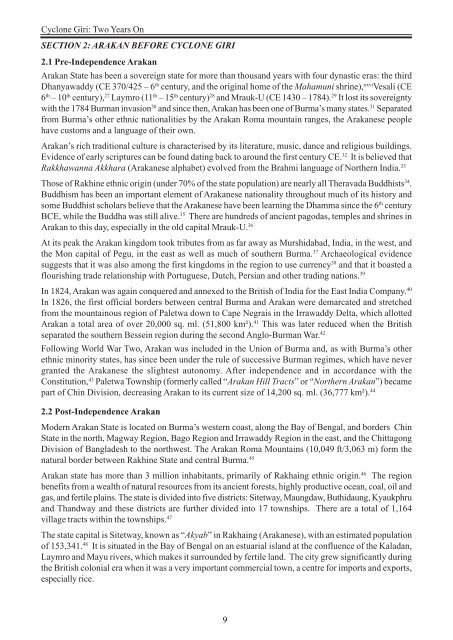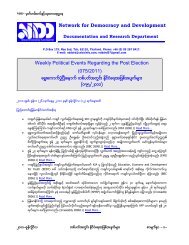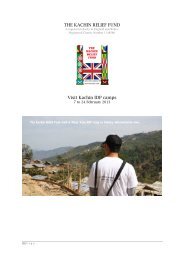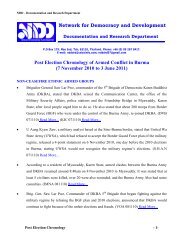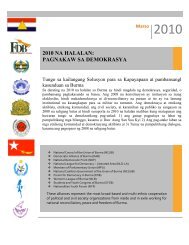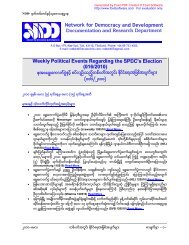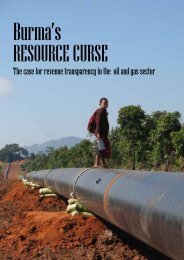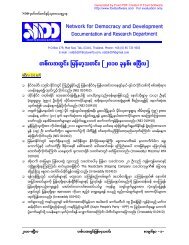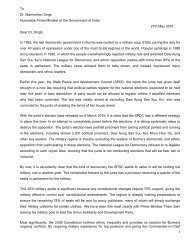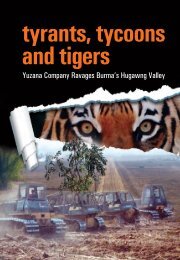Cyclone Giri - Two Years On - Burma Action Ireland
Cyclone Giri - Two Years On - Burma Action Ireland
Cyclone Giri - Two Years On - Burma Action Ireland
You also want an ePaper? Increase the reach of your titles
YUMPU automatically turns print PDFs into web optimized ePapers that Google loves.
<strong>Cyclone</strong> <strong>Giri</strong>: <strong>Two</strong> <strong>Years</strong> <strong>On</strong><br />
SECTION 2: ARAKAN BEFORE CYCLONE GIRI<br />
2.1 Pre-Independence Arakan<br />
Arakan State has been a sovereign state for more than thousand years with four dynastic eras: the third<br />
Dhanyawaddy (CE 370/425 – 6 th century, and the original home of the Mahamuni shrine), xxvi Vesali (CE<br />
6 th – 10 th century), 27 Laymro (11 th – 15 th century) 28 and Mrauk-U (CE 1430 – 1784). 29 It lost its sovereignty<br />
with the 1784 <strong>Burma</strong>n invasion 30 and since then, Arakan has been one of <strong>Burma</strong>’s many states. 31 Separated<br />
from <strong>Burma</strong>’s other ethnic nationalities by the Arakan Roma mountain ranges, the Arakanese people<br />
have customs and a language of their own.<br />
Arakan’s rich traditional culture is characterised by its literature, music, dance and religious buildings.<br />
Evidence of early scriptures can be found dating back to around the first century CE. 32 It is believed that<br />
Rakkhawanna Akkhara (Arakanese alphabet) evolved from the Brahmi language of Northern India. 33<br />
Those of Rakhine ethnic origin (under 70% of the state population) are nearly all Theravada Buddhists 34 .<br />
Buddhism has been an important element of Arakanese nationality throughout much of its history and<br />
some Buddhist scholars believe that the Arakanese have been learning the Dhamma since the 6 th century<br />
BCE, while the Buddha was still alive. 35 There are hundreds of ancient pagodas, temples and shrines in<br />
Arakan to this day, especially in the old capital Mrauk-U. 36<br />
At its peak the Arakan kingdom took tributes from as far away as Murshidabad, India, in the west, and<br />
the Mon capital of Pegu, in the east as well as much of southern <strong>Burma</strong>. 37 Archaeological evidence<br />
suggests that it was also among the first kingdoms in the region to use currency 38 and that it boasted a<br />
flourishing trade relationship with Portuguese, Dutch, Persian and other trading nations. 39<br />
In 1824, Arakan was again conquered and annexed to the British of India for the East India Company. 40<br />
In 1826, the first official borders between central <strong>Burma</strong> and Arakan were demarcated and stretched<br />
from the mountainous region of Paletwa down to Cape Negrais in the Irrawaddy Delta, which allotted<br />
Arakan a total area of over 20,000 sq. ml. (51,800 km²). 41 This was later reduced when the British<br />
separated the southern Bessein region during the second Anglo-<strong>Burma</strong>n War. 42<br />
Following World War <strong>Two</strong>, Arakan was included in the Union of <strong>Burma</strong> and, as with <strong>Burma</strong>’s other<br />
ethnic minority states, has since been under the rule of successive <strong>Burma</strong>n regimes, which have never<br />
granted the Arakanese the slightest autonomy. After independence and in accordance with the<br />
Constitution, 43 Paletwa Township (formerly called “Arakan Hill Tracts” or “Northern Arakan”) became<br />
part of Chin Division, decreasing Arakan to its current size of 14,200 sq. ml. (36,777 km²). 44<br />
2.2 Post-Independence Arakan<br />
Modern Arakan State is located on <strong>Burma</strong>’s western coast, along the Bay of Bengal, and borders Chin<br />
State in the north, Magway Region, Bago Region and Irrawaddy Region in the east, and the Chittagong<br />
Division of Bangladesh to the northwest. The Arakan Roma Mountains (10,049 ft/3,063 m) form the<br />
natural border between Rakhine State and central <strong>Burma</strong>. 45<br />
Arakan state has more than 3 million inhabitants, primarily of Rakhaing ethnic origin. 46 The region<br />
benefits from a wealth of natural resources from its ancient forests, highly productive ocean, coal, oil and<br />
gas, and fertile plains. The state is divided into five districts: Sitetway, Maungdaw, Buthidaung, Kyaukphru<br />
and Thandway and these districts are further divided into 17 townships. There are a total of 1,164<br />
village tracts within the townships. 47<br />
The state capital is Sitetway, known as “Akyab” in Rakhaing (Arakanese), with an estimated population<br />
of 153,341. 48 It is situated in the Bay of Bengal on an estuarial island at the confluence of the Kaladan,<br />
Laymro and Mayu rivers, which makes it surrounded by fertile land. The city grew significantly during<br />
the British colonial era when it was a very important commercial town, a centre for imports and exports,<br />
especially rice.<br />
9


